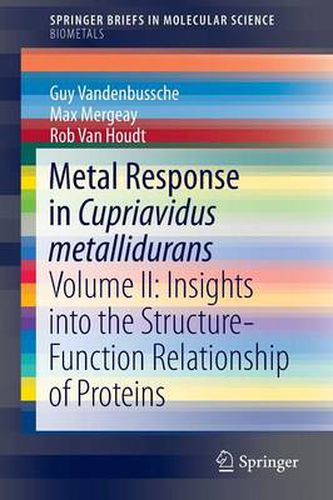Readings Newsletter
Become a Readings Member to make your shopping experience even easier.
Sign in or sign up for free!
You’re not far away from qualifying for FREE standard shipping within Australia
You’ve qualified for FREE standard shipping within Australia
The cart is loading…






This title is printed to order. This book may have been self-published. If so, we cannot guarantee the quality of the content. In the main most books will have gone through the editing process however some may not. We therefore suggest that you be aware of this before ordering this book. If in doubt check either the author or publisher’s details as we are unable to accept any returns unless they are faulty. Please contact us if you have any questions.
This book is the second volume of a two-volume set summarizing 40 years of key research findings directly related to metal-resistant Cupriavidus/Ralstonia (Betaproteobacteria). In this second volume, the structural and catalytic data from bacterial primary and secondary transporters (P-ATPases, tripartite chemiosmotic cation/proton efflux systems, cation diffusion facilitators, Major Facilitator Superfamily and some minor categories) are outlined and detailed for the corresponding C. metallidurans proteins. The available three-dimensional structures are reviewed in detail, including RND and membrane fusion proteins (from tripartite chemiosmotic cation/proton efflux systems), sigma and anti-sigma regulatory proteins of the cnr efflux system (resistance to cobalt and nickel) and various periplasmic proteins mainly involved in the response to copper and mercury. In addition, the first volume sketches the historical and geographical context of these bacteria, which are mostly found in industrial and polluted environments linked to zinc and other non-ferrous metallurgy, to illustrate the interactions between bacteria and human activities and the possible evolutionary consequences on bacterial genomes especially as far as the association of metal resistance genes with mobile genetic elements is concerned. It provides a detailed description of the response and underlying genetic determinants of type strain Cupriavidus metallidurans CH34 to a variety of metals. With high level resistance to cadmium, chromate, cobalt, copper, mercury, nickel, lead and zinc mediated by well-known genes for detoxification carried by its megaplasmids pMOL28 and pMOL30. This description is complemented with the genomic context of the metal response genes in C. metallidurans CH34 with a focus on its mobilome including insertion sequence elements, transposons, integrative and conjugative elements and genomic islands.
$9.00 standard shipping within Australia
FREE standard shipping within Australia for orders over $100.00
Express & International shipping calculated at checkout
This title is printed to order. This book may have been self-published. If so, we cannot guarantee the quality of the content. In the main most books will have gone through the editing process however some may not. We therefore suggest that you be aware of this before ordering this book. If in doubt check either the author or publisher’s details as we are unable to accept any returns unless they are faulty. Please contact us if you have any questions.
This book is the second volume of a two-volume set summarizing 40 years of key research findings directly related to metal-resistant Cupriavidus/Ralstonia (Betaproteobacteria). In this second volume, the structural and catalytic data from bacterial primary and secondary transporters (P-ATPases, tripartite chemiosmotic cation/proton efflux systems, cation diffusion facilitators, Major Facilitator Superfamily and some minor categories) are outlined and detailed for the corresponding C. metallidurans proteins. The available three-dimensional structures are reviewed in detail, including RND and membrane fusion proteins (from tripartite chemiosmotic cation/proton efflux systems), sigma and anti-sigma regulatory proteins of the cnr efflux system (resistance to cobalt and nickel) and various periplasmic proteins mainly involved in the response to copper and mercury. In addition, the first volume sketches the historical and geographical context of these bacteria, which are mostly found in industrial and polluted environments linked to zinc and other non-ferrous metallurgy, to illustrate the interactions between bacteria and human activities and the possible evolutionary consequences on bacterial genomes especially as far as the association of metal resistance genes with mobile genetic elements is concerned. It provides a detailed description of the response and underlying genetic determinants of type strain Cupriavidus metallidurans CH34 to a variety of metals. With high level resistance to cadmium, chromate, cobalt, copper, mercury, nickel, lead and zinc mediated by well-known genes for detoxification carried by its megaplasmids pMOL28 and pMOL30. This description is complemented with the genomic context of the metal response genes in C. metallidurans CH34 with a focus on its mobilome including insertion sequence elements, transposons, integrative and conjugative elements and genomic islands.